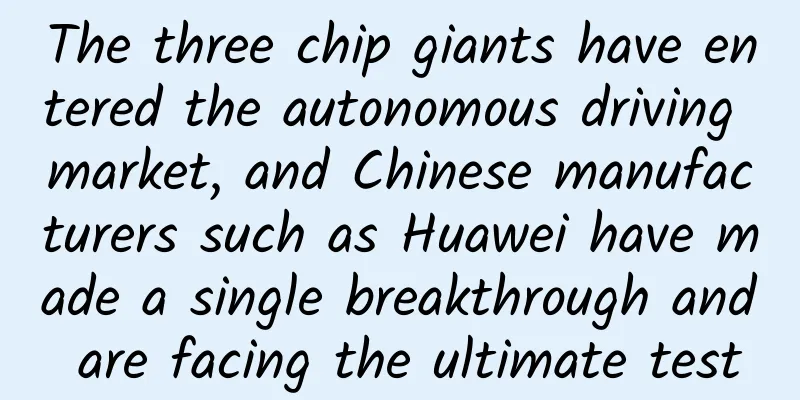The three chip giants have entered the autonomous driving market, and Chinese manufacturers such as Huawei have made a single breakthrough and are facing the ultimate test

|
Qualcomm, Intel and Nvidia, the three giant chip companies, are extending the boundaries of competition to autonomous driving. Chip giants' autonomous driving arms race Earlier this month, Qualcomm announced that it would acquire Swedish automotive technology supplier Veoneer for $4.6 billion (about RMB 30 billion). Veoneer later confirmed that it would start negotiations with Qualcomm. Prior to this, Canadian Tier 1 supplier Magna also showed strong interest in acquiring Veoneer and offered a $3.8 billion bid. Among Veoneer's many technologies, the Advanced Driver Assistance System (ADAS) is what they are most proud of. Veoneer's fourth-generation stereoscopic vision camera system uses a deep learning architecture, which can detect road conditions, identify road edges, and predict the actions of surrounding pedestrians and vehicles. It is this technology that made Qualcomm determined to pay a more generous offer than its competitors. Qualcomm has always been widely known for its business in the field of mobile communications, but they have always hoped to expand their influence to other fields. Since 2002, Qualcomm has begun to lay out in the automotive field. Its digital cockpit platform has been adopted by many automakers such as Ideal Auto, Xiaopeng Auto, and GAC, and its automotive solutions cover more than 100 million vehicles worldwide. Qualcomm has been in the automotive industry for a long time, but their presence does not seem to match their efforts, which is also intuitively reflected in the sales share: in 2020, Qualcomm's automotive business accounted for only 3% of chip sales. In the absence of a breakthrough, Qualcomm's automotive business urgently needs a shot in the arm. Therefore, Qualcomm chose to increase its investment in autonomous driving. Intel, the leader in computer chips, entered the autonomous driving field five years ago. In 2016, Intel acquired Yogitech, a self-driving car safety tool, Arynga, an in-vehicle computer OTA technology company, and Itseez and Movidus, a visual processing chip startup, and mastered a large amount of hardware technology. In 2017, Intel spent US$15.3 billion (approximately RMB 105.6 billion) to acquire Israeli autonomous driving technology company Mobileye. Mobileye was founded in 1999 and is mainly engaged in research in the field of automotive computer vision. Tesla's early advanced driver assistance Autopilot used the visual assistance solution provided by Mobileye. After the completion of this acquisition, Intel has formed a unique integrated hardware and software competitiveness in the field of autonomous driving. Compared with Qualcomm and Intel, NVIDIA has undoubtedly established a more mature ecosystem in the field of autonomous driving. It has built a unified GPU hardware architecture and CUDA software architecture around the car, desktop, and cloud, and also has amazingly powerful AI computing power. It is worth mentioning that NVIDIA is currently the only chip giant that can provide a unified architecture and unified software development environment for desktop, cloud and car. In April this year, NVIDIA launched the new autonomous driving SoC Atlan, with a single computing power of 1000TOPS, which exceeds the computing power of most L4 autonomous driving vehicles today. In June, NVIDIA acquired DeppMap to strengthen its R&D capabilities for high-precision maps. No one can question the technical depth of Qualcomm, Intel and Nvidia in chip development, and autonomous driving has extremely high requirements for chip computing power, so it can be said that it is a natural fit for these companies. At the same time, in the field of autonomous driving, chips alone are far from enough. If a complete ecosystem of algorithms and chips cannot be formed, it will be difficult to obtain higher single-vehicle value. Therefore, the giants have shown their talents one after another. Nvidia, which entered the market earlier, has been able to independently develop most of the software and hardware technologies and is in a leading position. Nvidia and Qualcomm have chosen to quickly make up for their own technological shortcomings through acquisitions, hoping to overtake others in the future. In fact, these three traditional chip giants have already created a huge leading advantage in the field of autonomous driving. At present, there is still a big gap between the manufacturing process of autonomous driving chips and that of consumer electronics. When mobile phones and computers are using 7nm or even 5nm process chips, 28nm process chips are still the mainstream in the field of autonomous driving. However, in order to improve the accuracy and safety of autonomous driving, the requirements for chip computing power and power consumption have been further improved, and the latest process chips have also begun to enter the field of autonomous driving. At this time, these companies with independent chip research and development capabilities can rely on self-developed chips to reduce costs. Another factor that cannot be ignored in autonomous driving is software, and "software-defined cars" has become a consensus in the industry. When commenting on Qualcomm's acquisition of Veoneer, an industry insider mentioned: "For high-end applications such as ADAS, software development is very complex. If the developed chips are not equipped with mature software, customers will basically be unable to use them." These chip giants all have complete software ecosystems: Intel has a software development team of 15,000 people, and Nvidia and Qualcomm have software platforms and developer communities for different products. Chip companies can use their own software ecosystems to create synergies between software, chips, and artificial intelligence algorithms. These international chip giants have adopted a platform strategy in the field of autonomous driving: based on strong chip development capabilities, and on this basis, combined with their advantages in cost control and software ecology, they have opened up the autonomous driving industry chain. In the past two years, domestic autonomous driving manufacturers have sprung up like mushrooms after a rain. Now that international giants have collectively entered the market, it is undoubtedly a big test for them. Domestic autonomous driving chip manufacturers "break through" at a single point At present, the penetration rate of L2 autonomous driving in the domestic market has soared from about 3% in 2018 to nearly 18% in the first quarter of this year. It was during this period that a large number of domestic companies entered this field, including new companies specializing in autonomous driving such as Horizon, as well as all-round technology giants such as Huawei. AI chip company Horizon Robotics was founded in 2015. Although it is not a long time old, their goal is very ambitious: to integrate hardware and software and provide customers with a complete solution of "chip + algorithm IP + tool chain". In July this year, Horizon Robotics released the latest ZT5 series chips, with a single chip AI computing power of up to 128 TOPS, ranking among the best among domestic chips. This is also the industry's first full-scenario vehicle intelligent central computing chip that integrates autonomous driving and intelligent interaction. After the release of ZT5, Horizon Robotics has become the only provider of full-scenario vehicle intelligent chip solutions in the industry that can cover from L2 to L4. But compared to the technology, Horizon's philosophy is more eye-catching. Current autonomous driving manufacturers generally follow the "Apple route" to build their own closed loop of software and hardware ecosystems. Horizon is more like the "Android route". CEO Yu Kai said that Horizon will not mass-produce hardware, software bundling and closed solutions, but will empower the smart car industry with the mindset of "all-dimensional altruism". Based on this concept, Horizon also released the in-vehicle operating system TogetherOS, which adopts an open architecture and partners from all industry ecosystems can participate in its construction. In the field of autonomous driving, car companies and third-party manufacturers often have grudges in their cooperation. SAIC refused to cooperate with Huawei because it did not want to hand over its "soul" to others. Horizon's more open attitude can help it attract more manufacturers. Even the mid-to-high-end model Ideal ONE, which costs more than 300,000 yuan, uses the ZT series chips. Huawei's layout for autonomous driving began in 2019. In that year, Huawei's intelligent automotive solutions department was established to develop full-stack solutions for intelligent vehicles, and the core of this is the "ADS advanced autonomous driving full-stack solution." Huawei's full-stack solution includes core components such as millimeter-wave radar, Huawei's self-developed 96-line medium- and long-range laser radar, and uses a specially customized super central supercomputer ADCSC, with a minimum starting computing power of 400TOPS and a high-end computing power of 800TOPS. In terms of software, Huawei's ADS solution can continuously accumulate environmental information and driving habits through machine self-learning, and iterate and optimize for complex scenarios. At the same time, in order to collect as many samples as possible, Huawei has also formed a team with Class A map mapping qualifications to collect a large amount of data in first-tier cities. In addition to the full-stack solution, Huawei has also launched the MDC solution, which integrates Huawei's self-developed Host CPU chip, AI chip, ISP chip and SSD control chip, with high energy efficiency, high performance, high security and low latency. In addition, Huawei MDC also has the characteristics of component service, interface standardization and development tooling. Based on this platform, autonomous driving algorithms and functions can be quickly developed, debugged and run. Huawei MDC has currently released four products with different computing power levels: MDC210, MDC300, MDC610 and MDC810. The most powerful MDC810 has a computing power of up to 400TOPS. At present, the Huawei HI version of the BAIC Arcfox Alpha S equipped with Huawei's ADS full-stack solution has been officially launched, and Huawei's MDC has also conducted L4 level autonomous driving tests on the Audi Q7. In addition to Horizon Robotics and Huawei, there are many domestic manufacturers active in the field of autonomous driving: the startup company Black Sesame has successfully trial-produced three high-computing-power autonomous driving chips, among which the "Huashan II A1000 Pro" has an INT8 computing power of 106 TOPS, an INT4 computing power of 196 TOPS, and a typical power consumption of 25W, which can meet the ISO 26262 ASIL D level functional safety requirements. Last year, Leapmotor also launched its first autonomous driving chip, Lingxin 01, which is also the first autonomous driving chip in China with completely independent intellectual property rights. Lingxin 01 has processing performance close to the top Mobileye chips in the market, and is more open overall. It can support general computing and has specific AI computing logic, with lower energy consumption ratio and higher safety and reliability. It can be seen that although domestic autonomous driving chip manufacturers generally started late, after several years of rapid development, they have all delivered solutions with their own characteristics. This also shows that in the field of new energy vehicles, Chinese companies are expected to break the technological monopoly of foreign companies and achieve latecomers overtaking. Of course, it is far from time to celebrate victory. Among the above-mentioned enterprises, Huawei's ADS solution has not yet found a second car company to cooperate with, and many chips from Horizon Robotics, Black Sesame, and Leapmotor have not yet been "installed" on a large scale. In future actual combat, challenges will surely follow. Who can surpass Tesla? At present, the most successful company in the field of autonomous driving is Tesla, which is a company that can achieve true full-stack self-development. In addition, software is also an important part of its revenue. Tesla's financial report shows that its FSD business brought the company $1 billion in revenue in 2020. Tesla expects that FSD's revenue will exceed car sales in the future. Software services have greater flexibility in business models and future expansion space. Taking Tesla's FSD as an example, users can currently choose a one-time purchase or a monthly subscription. At the same time, Tesla can also add new features at any time through OTA upgrades. Tesla's success undoubtedly has important reference significance for later generations. According to global market research firm Frost & Sullivan, the market size of digital mobility services in the automotive sector is expected to reach 1.9 trillion euros by 2025. Obviously, this is a big cake that no one will give up. Therefore, after the chip giants have completed their layout at the hardware level, the next stage of competition will most likely continue to revolve around software. For car companies, the first choice is definitely to develop their own full stack like Tesla, and firmly grasp their destiny in their own hands. Unfortunately, this requires too high a level of technology, and few companies can achieve it. Fortunately, many options such as NVIDIA, Intel, Huawei, and Horizon Robotics have been placed in front of car companies, and more cooperation will surely be the general trend. However, on the other hand, the car companies' desire to differentiate themselves will not change. It is not difficult to infer that customization of software and hardware will become the main theme of future cooperation between third-party manufacturers and car companies. Perhaps, in the upcoming battle of autonomous driving, in addition to the competition in computing power, whoever can truly integrate with car companies can be considered to have truly found the wealth code of the autonomous driving industry. As a winner of Toutiao's Qingyun Plan and Baijiahao's Bai+ Plan, the 2019 Baidu Digital Author of the Year, the Baijiahao's Most Popular Author in the Technology Field, the 2019 Sogou Technology and Culture Author, and the 2021 Baijiahao Quarterly Influential Creator, he has won many awards, including the 2013 Sohu Best Industry Media Person, the 2015 China New Media Entrepreneurship Competition Beijing Third Place, the 2015 Guangmang Experience Award, the 2015 China New Media Entrepreneurship Competition Finals Third Place, and the 2018 Baidu Dynamic Annual Powerful Celebrity. |
Recommend
A must-have for following hot topics in February | New media marketing hot calendar!
In 2017, the new media landscape underwent tremend...
Why did Douyin suddenly have no traffic? Why did Douyin's traffic suddenly drop to very little?
Now is the era where traffic is king. No matter w...
Never rent out your WeChat account, as you may become an accomplice to crime. The authorities will crack down on this severely!
"High price to buy V, if you don't want ...
Under market pressure, the development of mechanical hard disks may be difficult to continue
Solid-state drives are becoming more and more pop...
The three chip giants have entered the autonomous driving market, and Chinese manufacturers such as Huawei have made a single breakthrough and are facing the ultimate test
Qualcomm, Intel and Nvidia, the three giant chip ...
It's a cold dish, but it's a good one. Trails in the Sky FC Evolution: Try it before you buy it
As an excellent work on PSV that has received rav...
Design of self-propagation activities for inviting new users to share based on the perspective of funnel model
Students who work in operations all know the AARR...
How to promote videos on Bilibili? Guide to promoting videos on Bilibili!
Bilibili is a video community based on creation, ...
Where does the back of the belly button lead to?
Follow "Body Code Decoding Bureau" (pub...
In order to capture users, these 6 elements must be obtained when launching a product!
Product launch is a very important matter because...
Price inquiry for Benxi mobile app production. How much does it cost to produce Benxi mobile app?
The launch of mini programs has brought convenien...
A deep dive into the hidden rules of “WeChat Points Wall”!
In APP operation and promotion, especially iOS pr...
The first "willow catkins forecast"! You read that right, it's here again
Spring is here The flowers are in full bloom in B...
Monthly turnover of 60 million was selected into Tencent's social advertising game white paper, reviewing the advertising case of "Huluwa"
The buying volume market has exploded in the past...
Samsung Galaxy S5 first test
Let's start with the appearance. The design of...









